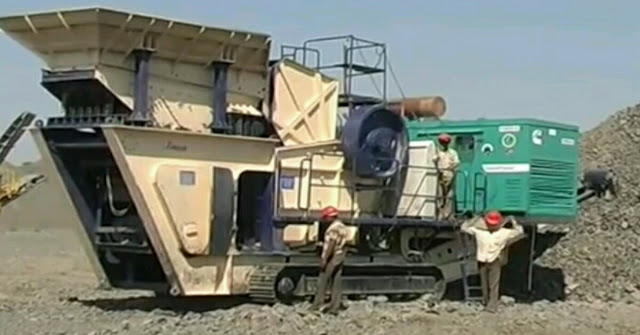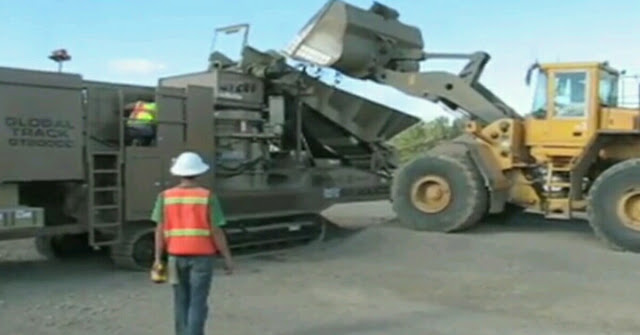Contents:
1.Types and properties.
2. Selection criteria for production.
1. Types and properties.
 |
| Machine type and production capacity must be adjusted to the needs |
Depending on the method used to mill the original stones and their construction, jaws, cones, rotors, rollers and centrifuges are dispensed, with some being combined. Some are universal and suitable for every stage of gravel production, others are used only in the first or the next step. Classically, they are divided into stationary (large-scale mining) and mobile devices that are in greater demand because of the ability to work in any desired location. The selection of a particular crushing plant is based on their destination.
The jaw designs are universal, but are mainly used in the primary treatment of rocks of any hardness. In this case, the ballast is produced by pressing the raw material poured through the upper part between two corrugated plates of high-strength metal alloys while controlling the proportion by changing the gap at the time of approaching. The worn elements change as needed, the process of crushing stones and gravel is not difficult.
The performance of jaw crushers in the treatment of quarrystone depends on the parameters of the opening of the load, the specified size of the fractions, the frequency of vibration of the moving plates, the angle of detection and the hardness of the quarrystone. the original rock. The standard range of these models ranges from 1 to 500 m3 / h. With good productivity and relatively easy maintenance, they require frequent inspections and consume large amounts of energy. Its parts often wear under the influence of vibrations and abrasive loads, and the quality of the material obtained leaves much to be desired (the proportion of grains having an irregular shape in the total mass is too high).
The cone crushers have a similar operating principle, but due to the three-dimensional shape of the abraded plane and the unbalanced axis of rotation, the parts are machined to a higher quality. They make it possible to obtain crushed stones with little desquamation and permanent fracture composition. They are characterized by a high productivity and a relatively low energy consumption, the purchase is recommended when large amounts of medium-grained material are needed. Considered features include volume and low maintainability.
The operating principle of the roller devices is based on the crushing of gravel and gravel medium fractions by crushing or splitting between two or four gears, the waves rotate smoothly. The performance of these devices depends on the rock type, the size of the work elements (including the loading slot) and the rotation frequency. It is recommended to purchase mainly for after-treatment, especially for grinding low and medium density gravel. Most models of this type are made by Chinese manufacturers. Used roll crushers are cheaper than others, but their reliability is not guaranteed.
The rotary or hammer types have a similar purpose, they allow to obtain the smallest gravel, but they are not suitable for grinding too hard rock. The grinding takes place under both the impacts of the elements mounted on the barrel and in contact with the inner walls. The fractions are regulated by changing the distance between the grid and the ends of the hammers. With activated rotor chippers, a diffusion screen is additionally introduced into the circuit. In view of this, it is recommended that they be purchased as part of a complex and used exclusively for secondary treatment. Otherwise, they break up quickly.
With centrifugal aggregates, rocks with a breaking size of 100 mm are ground down to the smallest size. Polishing occurs when overclocked parts are hammered into or between the liners. As this variety is less used than others, the risk of imbalance of the working axis is considered to be a serious disadvantage. Centrifugal models are mainly concerned with the production of construction sand or the processing of slag and secondary soil.
2. Selection criteria for production.
 |
| The ease of obtaining machine parts is very necessary and also a quick repair |
The following properties and factors are taken into account when selecting the devices:
1. Power breakers For laboratory tests and individual work, mini-installations (less than 1 m3 / hour) are sufficient; In other cases, this indicator depends on the processing volume.
2. Reader type and power consumption. Most models have an electric motor, but if necessary, you can buy equipment associated with tires or diesel. The focus is on the cooling method of the device. With a lot of work, devices with forced systems are preferred to natural systems.
3. The permissible dimensions of the rock to be filled, determined by the design of the loading port, the required parameters of the fractional composition at the outlet. Universal models include screw and cone variants, the latter being recommended as a cubic debris breaker. To better recycle the suitable and rotating rollers.
4. Dimensions and weight of the system, volume of the loaded funnel.
5. Availability of remote controls, dust collection systems, magnetic separators and other auxiliary functions, eg. B. Special gripper for loading
6. When purchasing used units, in addition to the general assessment of the state, account is taken of the number of hours worked, this should not be too important.






No comments:
Post a Comment